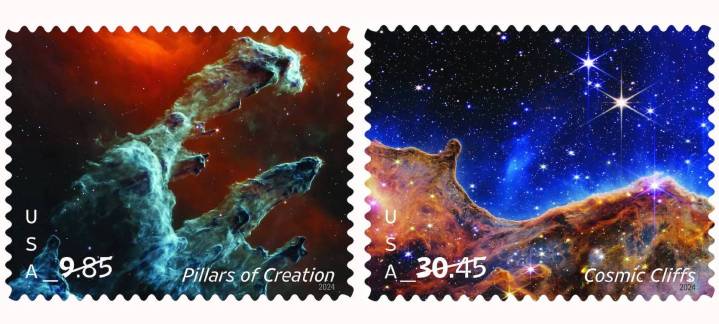
Beautiful images captured by the James Webb Space Telescope have landed on a new set of stamps issued this week by the U.S. Postal Service (USPS).
The James Webb Space Telescope is the most powerful and most advanced telescope ever sent to space, and soon after its launch in December 2021, it’s been beaming back stunning imagery and gathering huge amounts of data that’s enabling astronomers to learn more than ever before about distant galaxies.
The USPS’s latest Priority Mail stamps were issued on Monday, January 22, and feature images captured by Webb that include the Pillars of Creation and the Cosmic Cliffs.
The Pillars of Creation image was captured by Webb’s MIRI (Mid-Infrared Instrument). This is a region within the vast Eagle Nebula, which lies some 6,500 light-years from Earth, and the image shows pillars of gas and dust enshrouding stars that are forming very gradually over many millennia.
The other stamp features Webb’s NIRCam (Near-Infrared Camera) image of the Cosmic Cliffs in the Carina Nebula around 7,600 light-years away and reveals emerging stellar nurseries and numerous individual stars.
“NASA’s James Webb Space Telescope is the perfect intersection of science, engineering, and art as it reveals the greatest secrets of our cosmos through the beautiful images it captures,” Nicola Fox, NASA’s associate administrator of the Science Mission Directorate, said on the day of the stamps’ launch.
Fox added: “With these stamps, people across the country can have their own snapshot of Webb’s captivating images — and the incredible science they represent — at their fingertips, and know that they, too, are part of this ground-breaking new era in astronomy.”
This is the second issue of U.S. stamps to celebrate the James Webb Space Telescope after the USPS launched its first set in August 2022, a short while after NASA shared the first images captured by Webb.
That stamp features an artist’s digitally created depiction of the telescope with a dazzling starscape as a backdrop.


